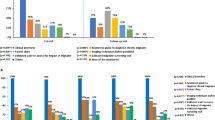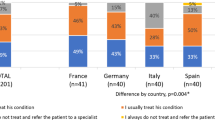Abstract
Migraine is a common chronic headache disorder affecting more than 10% of persons in Western populations. The clinical management of migraine is notable for the variability of diagnostic testing, therapeutic interventions and cost. Standards of care and clinical guidelines for migraine have recently been published or are currently under development. For these reasons, migraine is an ideal disease for a disease management programme.
This article outlines the key concepts in developing a disease management programme for migraine which include: setting appropriate goals of migraine disease management; identifying patients for enrolment; providing critical components of care; instituting appropriate referral guidelines; and using continuous quality improvement methods to reach desired goals. Appropriate goals of migraine disease management should focus on decreasing migraine frequency and/or severity and improving quality of life for individuals who experience migraine.
Additional goals may include reducing: overall cost to the organisation; pharmacy costs for migraine therapies; and emergency department and urgent care patient visits. Methods for identifying patients for enrolment in a migraine disease management programme include screening patients in various clinical settings, reviewing pharmacy records or self-enrolment. Key components of care include diagnostic and treatment algorithms, instruments to monitor quality of life, and education programmes for practitioners and patients. The final step in designing a disease management approach to migraine is to ensure that the process is continuously undergoing analysis and improvement.
Similar content being viewed by others
References
Pryse-Phillips W, Edmeads J, Murray TJ, et al. A Canadian epidemiological study of headache prevalence. Can J Neurol Sci. 1992; 19: 333–9.
Stewart WF, Lipton RB, Celentano DD, et al. Prevalence of migraine headache in the United States. JAMA. 1992; 267: 64–9.
Edmeads J, Findlay H, Tugwell P, et al. Impact of migraine and tension-type headache on life-style, consulting behaviour, and medication use: a Canadian population survey. Can J Neurol Sci. 1993; 20: 131–7.
Solomon GD, Skobieranda FG, Gragg LA. Quality of life and well being of headache patients: measurement by the Medical Outcomes Study Instrument. Headache. 1993; 33: 351–8.
Osterhaus JT, Townsend RJ, Gandek B, et al. Measuring the functional status and well-being of patients with migraine headache. Headache. 1994 Jun; 34: 337–43.
Mannix LK, Solomon GD. Measuring improvement in headache patients: comparison of patient global assessment, health-related quality of life, and disability instruments. Presented at the 4th Annual Symposium of Contributed Papers Quality of Life Evaluation; 1997 May 13: Charleston.
Pryse-Phillips W, Dodick DW, Edmeads JG, et al. Guidelines for the diagnosis and management of migraine in clinical practice. Can Med Assoc J. 1997; 156: 1273–87.
Solomon GD, Cady R, Klapper J, et al. National Headache Foundation: standards of care for treating headache in primary care practice. Cleve Clin J Med. 1997; 64: 373–83.
Kozma CM, Kaa KA, Reeder CE. A model for comprehensive disease state management. J Outcomes Manage 1977 Feb: 4–8.
Ellrodt G, Cook DJ, Lee J, et al. Evidence-based disease management. JAMA. 1997; 278: 1687–92.
Lipton RB, Stewart WF. Clinical applications of zolmitriptan. Cephalalgia. 1997; 17 Suppl. 18: 53–9.
American Academy of Neurology. Practice handbook. Minneapolis: American Academy of Neurology, 1995.
Mannix LK, Solomon GD, Kippes C. Impact of headache education program in the workplace. Presented at Migraine Trust; 1998 Sep; London.
Lewis T, Solomon GD. Advances in migraine management. Cleve Clin J Med. 1995; 62: 148–55.
Author information
Authors and Affiliations
Corresponding author
Rights and permissions
About this article
Cite this article
Solomon, G.D. Interventions and Outcomes Management in Migraine. Dis-Manage-Health-Outcomes 3, 183–190 (1998). https://doi.org/10.2165/00115677-199803040-00003
Published:
Issue Date:
DOI: https://doi.org/10.2165/00115677-199803040-00003




